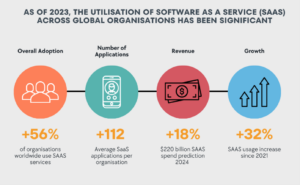What do MICROSOFT, ORACLE, SALESFORCE, SAP, ADOBE all have in common… we’ve all been subject to them at some point and we’re all at their mercy when it comes to pricing renewals.
The corporate environment has drastically changed, that’s a fact. As employees, we cannot go 3-minutes without some form of push notification. For both Procurement and IT teams, managing these business-critical Products oftentimes feels like navigating the ring roads of Milton Keynes.
Price increases, compliance audits, over usage, underutilisation, user-adoption… those are typical challenges we all face on an annual basis and underpin our decision-making process regarding investments and strategies around our major products and platforms.
But what about the tail-end? Those countless lower cost products part of our estate, the auto-renewals, the duplicates, the freeware, or even the antiviruses! What if we told you that within this corporate maze lies a trove of cost savings and efficiency?

Utilization rate of software as a service (SaaS) worldwide (2024); Gartner Forecasts Worldwide Public Cloud (2023)
With the above key facts in mind, wouldn’t you expect Software Asset Management (SAM) tooling to be part of every organisation in this modern age? The answer is… ‘not just yet’.
The good news is SAM adoption and deployment is rising rapidly. Based on the 2023 publication from Grand View Research, the global SAM market was valued at approximately $3.14 billion in 2023 and is projected to grow at a compound annual growth rate (CAGR) of 16.2% between 2024 to 2030.
At its core, SAM is about more than just keeping track of your licensing estate. Think of it as an efficient and clinical software inventory of an organisation, uncovering hidden inefficiencies and ensuring every software asset is used to its fullest potential.
The SAM tooling market provides a variety of choice to small enterprises all the way to well established companies; Products and Platforms accommodating size and complexity of Software & Application environments (e.g. Snow Commander; ServiceNow; Ivanti).
SAM products aren’t just cost saving tools, they can provide further features and process enhancements to support day to day operations such as (but not limited to):
- Automations (e.g. software deployment, license tracking, and compliance check)
- Notification renewals and expiry
- Audit reconciliation reports
So, what can those tools help you achieve? And why should non-IT stakeholders consider SAM in their thinking process daily?
- Eliminating Redundancies: SAM helps identify and eliminate unused or redundant software licenses. This means you’re only paying for what you use, which can lead to significant cost reductions.
- Avoiding Penalties: Compliance with software licensing agreements is crucial. SAM ensures organisations stay on the right side of the law, avoiding hefty fines and legal fees.
One of the most compelling mysteries SAM solves is the riddle of cost savings. Software products and applications are no longer commodities managed by an IT department. The State of SaaS Sprawl (2021) report found that 56% of SaaS applications are not owned or managed by a company’s IT department.
Budgets are still found to be carved into capability segments across the business for various reasons:
- Flexibility and responsiveness – allowing departments and business units to rapidly respond to user needs.
- Local expertise – business units often have a better understanding of their unique requirements.
- Reduced bureaucracy – centralised budgeting can sometimes hinder agility and decision-making processes.
It is therefore crucial for an organisation to instore SAM tooling at enterprise level to help monitor/control shadow IT and reducing sporadic costs from occurring.
The Procurement Plethora
Procurement plays a crucial role in the software asset management process. Here’s how Procurement can contribute to the mystery-solving:
- Strategic Purchasing: Cost Optimisation programmes and a strategic approach will help you acquire the right tools without overspending.
- Negotiation Skills: Choosing the right partners to support you throughout this journey is crucial! This can lead to better pricing, extended support, and additional features at no extra cost (Gartner, 2022).
- Contract Management: In 2019 the International Association for Contract and Commercial Management (IACCM) estimated that the average contract leaks 9.5% of value over its lifecycle. Keeping track of software contracts, renewals, and expirations is a daunting task. Procurement and Contract Management departments will usually manage these aspects efficiently, but it is crucial for organisations to recognise the need for investment in upskilling their workforce to reduce the gap.
What next?
Software Asset Management enables the banking of benefits that go beyond your typical cost savings. By strategically managing software assets and leveraging procurement expertise, organisations can achieve greater efficiencies, enhance security, and compliance.
As the Software and Application market continues to grow exponentially, it is imperative for organisations to focus their efforts in controlling and managing their IT estate.
4C’s digital procurement experts have helped numerous clients manage their software portfolio to support better outcomes, helping stabilise costs and achieving higher ROI. Contact Joe Gibson or Allison Ford-Langstaff to discuss your challenges and how we can help.
References:
- 103 SaaS Statistics and Trends for (2024);
- 8-Step Playbook to Optimize Software and SaaS Negotiations; Gartner (2022);
- Centralization vs decentralization: Making better choices for your organization | McKinsey (2011);
- Cyber security breaches survey (2024);
- Gartner Forecasts Worldwide Public Cloud End-User Spending (2023);
- Software Asset Management Market analysis report (2023);
- State of SaaS Sprawl” Report (2021);
- The Advantages of Data-Driven Decision-Making; Harvard Business School blog (2019);
- To Centralize or Not to Centralize? BCG publication (2015);
- Upskilling for better contract management; Civil Service Report (2019);
- To Centralize or Not to Centralize? BCG publication (2015)
Published
December 19th 2024